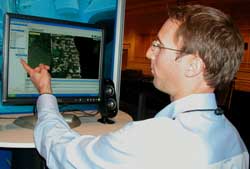 |
| Momentum. Field-forced automation is driving construction "backwards," Bradshaw explains. |
Like the border of a giant jigsaw puzzle, global positioning systems are starting to bring together electronic management tools. The complete picture won't be clear though until all the pieces fit.
Engineers can expect the puzzle to remain on the kitchen table for a few more years, perhaps decades, as the industry works out the kinks.
For one, construction moves at a snail's pace, technologically speaking. Firms have been slow to incorporate GPS into survey, design and project delivery because of its complexity. (related ENR cover story Oct. 3, 2005 3D Grade Control Puts Designers Right in the Operator's Seat)
Today, the industry's use of GPS is just "scratching the surface," says Steven Berglund, president and CEO of Trimble Navigation Ltd., Sunnyvale, Calif.
But a steadily growing interest in automation has more civil engineers buzzing about its potential. Early GPS adopters are trying to take it to another level, too. It is not just about locating things or people anymore; some proponents believe that GPS could become a total jobsite management tool.
 |
| Supervisors can pull up jobsite information on a wireless phone. |
Everyday items, such as mobile phones, bulldozers and robotic total stations are starting to converge, and it is all because of GPS, says Clint Brown, director of software for ESRI Inc., a geographic information firm in Redlands, Calif.
"We are data-rich," he says, but adds that users still have a long way to go: "I don't necessarily think we are information-rich, yet."
Just how slow is the industry moving? According to Chris Bradshaw, vice president of infrastructure for Autodesk Inc., San Rafael, Calif., only 10 percent of the world's civil design firms work regularly with three-dimensional models, which need GPS for accurate planning.
 |
| Bird's Eye. Trimble representative Daniel Wallace demonstrates a GPS management tool. |
Software experts believe that global positioning will ultimately drive more designers into the 3-D realm because real-time positioning makes models more intelligent. "I think the whole industry is moving toward model-based design," Bradshaw predicts.
Ironically, the push is coming from the field, and that is forcing engineers to work "backwards," he notes. Software providers are rushing to update their modeling programs to incorporate things such as pay items, which help project teams estimate and invoice.
Outside of the design world, even fewer people use global positioning for such tasks as guiding construction machinery, according to Michael Ritter, general manager of Trimble's construction services division. Automatic machine control can cut the time is takes to grade sites, for example, by as much as 50 percent.
Compared to the rest of the world, "The U.S. is leading," Ritter explains. In the future, "I don't know that every firm will have every machine equipped," he adds, but most will use it in some way "to stay alive."
Firms that adopted GPS and machine control within the last few years are starting to take it beyond moving dirt and tracking location. Now, they want to leverage their wireless network to automate jobsite data collection, invoicing and payroll.
Some are seeing early results. "The data is coming at us in big, big batches," said Don Taylor, vice president of McAninch Corp., a West Des Moines, Iowa-based contractor. He spoke to a standing-room-only crowd at a Trimble user conference held Oct. 23-26 in Las Vegas. In all, about 1,300 construction people attended the four-day event.
Ben Brown, project manager for Cherry Hill Construction Inc., Jessup, Md., noted that his company is saving at least $62,000 a year using a GPS system that tracks people and assets. The company has saved even more with GPS-based machine control, but Brown did not say how much.
Taylor is trying to use GPS to measure jobsite performance, which is traditionally done with a stopwatch and time sheet. That older technology is what "we are trying to supplant," he explained.
This past June, McAninch equipped about 10 articulated dump trucks with proximity sensors and GPS communications. The sensors track load time and driving distance as operators complete dump cycles during their shifts. The data then populates on a computer at the corporate office.
Company executives are using the pilot test to run a daily report on earthmoving operators. Eventually, McAninch hopes to use the system to get paid faster. It also hopes to base machine operators' pay on real performance metrics.
The automation could have safety benefits, as well. GPS allows managers to see who is working consistently, and who is bleeding the bottom line. "They can eventually become better and better operators," Taylor noted.
For equipment in Brown's fleet, "we want to know whether it's sitting, whether it's moving, whether it's at McDonald's," he said.
Cost for such tracking run about $695 to equip each machine with a satellite-based GPS tracker. In addition, Brown pays a monthly Internet access fee of $40. For $15 more, he can monitor progress on his cell phone.
(All photos by Tudor Hampton for ENR)

Post a comment to this article
Report Abusive Comment